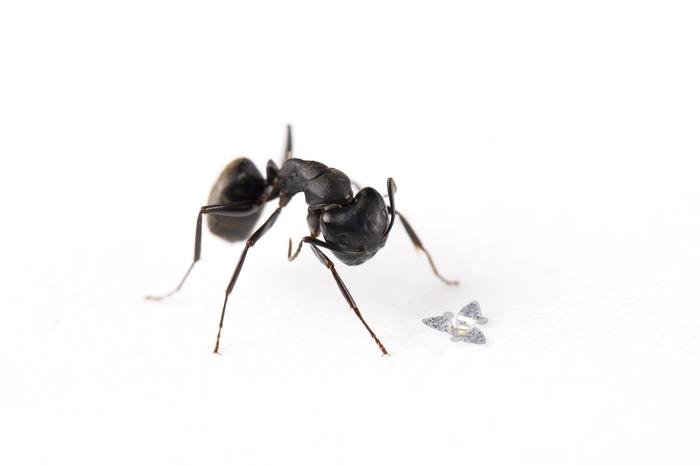The microflier is smaller than an ant -- roughly the size of a grain of sand -- uses the wind to fly and disintegrates in water once its flight has ended. Photo by Northwestern University
Sept. 22 (UPI) -- Engineers at Northwestern University have shrunk a microchip to roughly the size of a grain of sand and given it the power of flight.
The new "microflier" -- detailed Wednesday in the journal Nature -- is the world's smallest flying structure.
Previous efforts to shrink robots down to this size, such as one by Purdue researchers to create robots that are the size of a grain of sand, have required "force fields" or other methods to control their flight, but Northwestern researchers have thrown these ideas to the wind -- literally.
Without a motor, the flying microchips rely on the wind to remain airborne. When designing the microflier's wings, engineers used a maple tree's propeller seed -- and several other other wind-dispersed plant seeds -- as inspiration.
Like maple seeds, the microflier spins when dropped from a high elevation. The rotary action slows the microchip's descent, allowing it to float gently through the air, interacting with local air currents.
Researchers designed the flying microchips to be deployed by the dozens, released and allowed to disperse from high in the air. The microfliers could be outfitted with sensors and antennas to collect measurements and store data.
In the near future, fleets of microfliers could be deployed to monitor air pollution and airborne disease.
"Our goal was to add winged flight to small-scale electronic systems, with the idea that these capabilities would allow us to distribute highly functional, miniaturized electronic devices to sense the environment for contamination monitoring, population surveillance or disease tracking," study corresponding author John A. Rogers said in a press release.
"We were able to do that using ideas inspired by the biological world," said Rogers, a professor of material science at Northwestern.
German researchers previously created small, winged drones that act and look like butterflies, though the electronics on board -- and thus, their abilities -- were limited. Rogers' team opted, however, not to mimic creatures like insects or other animals.
The maple tree's propellor seeds evolved to fall slowly to the ground. The seeds' prolonged descent increases their odds of being carried away by the wind and establishing new tree stands.
Though maple seeds offered the most well-known inspiration, engineers ultimately modeled their flying microchip after the star-shaped seeds of the tristellateia plant. The vine's seeds boast bladed wings the enact a slow, controlled spin during descent.
After considering a variety of winged structures similar to the seeds of the tristellateia plant, researchers used models to understand exactly how each 3D structure would interact with the air during descent.
"Over the course of billions of years, nature has designed seeds with very sophisticated aerodynamics," Rogers said. "We borrowed those design concepts, adapted them and applied them to electronic circuit platforms."
Rogers and his colleagues optimized the shapes of the microflier's wings to create a slow, controlled rotation.
To manufacture the microchip's wings, researchers used the principle's of a children's pop-up book to turn 2D precursor components into a 3D structure. When stretched, the bonded rubber substrate remains flat, but when allowed to relax, it buckles to form the 3D winged structure.
In lab tests, scientists successfully outfitted microfliers with all sorts of accessories: data storage, sensors capable of detecting particulate matter, photodetectors for measuring sun exposure, antennas capable of sending data to a nearby computer or tablet. Researchers even granted their microfliers the ability to harvest ambient energy.
The research suggests microfliers could be accessorized to perform all kinds of monitoring tasks.
This could include being dropped from a plane or the top of a building to measure local atmospheric conditions or to measure air pollution in the wake a chemical spill.
"Most monitoring technologies involve bulk instrumentation designed to collect data locally at a small number of locations across a spatial area of interest," Rogers said.
"We envision a large multiplicity of miniaturized sensors that can be distributed at a high spatial density over large areas, to form a wireless network," Rogers said.
To avoid adding to the planet's pollution problem, Rogers and his research partners are currently experimenting with the construction of microfliers using materials that disintegrate in water shortly after their mission is complete.
Researchers have previously used such materials to build so-called "transient electronics."
"We fabricate such physically transient electronics systems using degradable polymers, compostable conductors and dissolvable integrated circuit chips that naturally vanish into environmentally benign end products when exposed to water," Rogers said.
"We recognize that recovery of large collections of microfliers might be difficult. To address this concern, these environmentally resorbable versions dissolve naturally and harmlessly," Rogers said.















